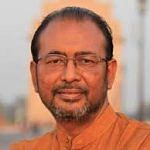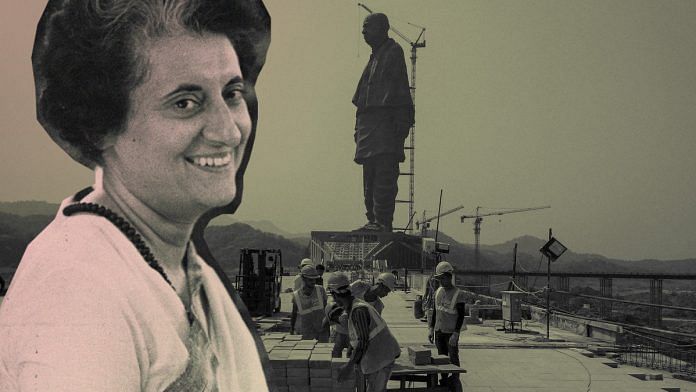A ₹2,989-crore “Statue of Unity” of Sardar Vallabhbhai Patel, touted as the tallest statue in the world, was inaugurated by Prime Minister Narendra Modi on the leader’s 143rd birth anniversary. Today also happens to be former PM Indira Gandhi’s death anniversary.
ThePrint asks: Has Sardar Patel eclipsed Indira Gandhi today or is he finally getting his due in history?
What Patel achieved was far beyond anything Indira Gandhi did and is finally getting his due
 Hindol Sengupta
Hindol Sengupta
Author, The Man Who Saved India: Sardar Patel and his idea of India
There is no question of an eclipse because there is no comparison. The odds that Sardar Patel battled to bring the princely states into the union of India, and especially considering the state of his health at that time, cannot in any way be compared with Indira Gandhi’s tallest moment, the victory in the Bangladesh war.
Indira Gandhi was a powerful Prime Minister at that time and commanding an army unsurpassed in its hegemonic power in the subcontinent. Sardar Patel had the strength of his towering personality and the backing of armed forces, but the strength of those forces and their loyalty against formidable local princes was questionable. The modern nation-state was just being formed and there was great uncertainty at various levels. So, what Patel achieved was far beyond anything Indira Gandhi did. This does not take away from her calibre, but it is to point out that this comparison is inaccurate. That Patel was given a Bharat Ratna only in 1991 will always be a very dubious thing in Indian history. Even two decades ago, Patel biographers were saying that attention the paid to him has been insufficient. I do believe that in many ways Patel is only now getting his due.
Congress, especially under Sonia Gandhi, did not have courage to disown Patel but underplayed his memory
 Nilanjan Mukhopadhyay
Nilanjan Mukhopadhyay
Author and journalist
Much before contemporary politics of appropriating historical memories took root, my generation learnt in school history textbooks that Sardar Vallabhbhai Patel was India’s ‘Iron Man’. Obviously, the Congress, being vilified for distorting history, did not underplay the Sardar or other non-Nehruvian nationalist icons to the extent they are being now accused off. The image of the stern-faced Sardar got embossed in our generation’s mind around the time India Gandhi began being referred to as Durga – mistakenly attributed to Atal Bihari Vajpayee for decades – for her valorous leadership during the 1971 war with Pakistan.
Indira Gandhi fell off the mantle of national icons for her authoritarian machinations during Emergency only to stage a weak return in the national consciousness. Her assassination alone led to her elevation as independent India’s first political martyr. By then, the Congress had started sidelining most nationalist icons beside Gandhi and Nehru. Sardar Patel, or Ambedkar for that matter, may have been bestowed the Bharat Ratna posthumously only in the 1990s (while Nehru and Indira both awarded themselves), yet, in people’s memory, they remained imprinted by their epithets.
The Modi government, 2014 onward, has consciously ignored Indira’s death anniversary in the hope that she will be eclipsed in history. The Congress, especially under Sonia Gandhi, did not have the courage to disown Patel but underplayed his memory. This, however, didn’t erase the Sardar from public reminiscence. Indira will remain etched in people’s mind with all her strengths and imperfections. She and the Sardar have their distinct niches for playing different roles at two distinct moments of history. Only insecure leaders imagine that publicity is the only way to keep memories alive.
You can’t compensate injustice to Sardar’s memory with a Disneyland-like attraction
 Urvish Kothari
Urvish Kothari
Senior columnist and writer
To claim or assume that building world’s tallest statue in the name of Sardar Patel can get him the rightful place in history shows ignorance and lack of common sense.
Statue of Unity can be a tourist spot with people taking selfies at Sardar’s feet and from the balcony carved out of his chest. But the sheer size of this “Made in China” statue and the celebration surrounding it indicate megalomania of its chief visualiser – the Prime Minister.
If Sardar is the tallest in history by virtue of this statue, what would one make of his guru Gandhi and his place in the history, not to mention many other stalwarts? Are we going to measure historical importance in metres?
To compensate the injustice done to Sardar’s memory with building something similar to a Disneyland – a tourism attraction – misses the whole point of Sardar’s true legacy. His legacy lies in service of the country without self-projection, disdain for pomp and verbose, striking simplicity, rock-solid determination in testing times and an effort to unite and not divide people of India.
It is difficult to understand how the Statue of Unity, chiefly a show by a Prime Minister not known for his inclusive tendencies, embodies any of the features of his legacy.
The same applies to his unjust comparison with Indira Gandhi. Both had different set of ideals, morality and represented almost opposite culture in public life. There is no question of Sardar Patel eclipsing Indira Gandhi. Sardar was and will be taller than her, not by inches but by miles, with or without the statue.
Also read: The inside story of how ‘Statue of Unity’ helped make Narendra Modi Prime Minister in 2014
By promoting Sardar Patel, Modi is promoting his own symbolism
 Rita Kothari
Rita Kothari
Professor, Ashoka University
I don’t think Sardar Patel is BJP’s answer to Indira Gandhi. He is Gujarat’s answer to Jawaharlal Nehru. Ever since I was little, I have been hearing in Gujarat about how Nehru supplanted Sardar’s rightful position as the first Prime Minister of India. In fact, some of the quiet anger against Gandhi is also about this. The indifference, almost studied hostility, towards Nehru is evident in many ways – lack of memorialisation in both public memory and spaces. Nehru appears in Gujarat’s public discourse only as a counterpoint to Sardar.
The biggest compliment Modi received from the people of Gujarat is that he is called sometimes ‘chhote Sardar’, an appellation used occasionally also for Chimanbhai Patel, a former chief minister of Gujarat. The image invokes a set of qualities – pragmatism, non-Anglicised, grassroots-born decisive leadership – a combination of both regional and national impulses. More importantly, it indicates a lack of patience with “fluffy” secularism. In promoting Sardar Patel, Modi is promoting his own symbolism.
What is the irony of the above statement? One is that Indira Gandhi is not relevant to the argument, and yet some of Modi’s style is closer to her’s than to Sardar’s. Another irony is that the regional leadership of Sardar Patel was not reflective of the divisions in the region.
Modi started process of making 31 Oct more about Patel than Indira Gandhi since 2013
 Shivam Vij
Shivam Vij
Contributing editor, ThePrint
Usually, the thought of Indira Gandhi’s assassination on 31 October 1984 quickly gives way to remembering the terrible pogrom of Sikhs that followed. This 31 October, she is not being remembered even for the riots.
With his ‘Run for Unity’ on 31 October 2013, Narendra Modi started the process of making this day more about Sardar Vallabhbhai Patel than Indira Gandhi. By 2018, the process is complete with the inauguration of Sardar Patel’s 597 feet-high statue by the Narmada. Amongst students, youth and farmers alike, Modi has ingrained the idea of 31 October as the day of Sardar Patel. Such efforts tend to leave lasting impact on young minds.
The Congress party has neither been able to defend the memory of Indira Gandhi, nor retain the ownership of Sardar Patel. One day the BJP might even appropriate Indira Gandhi, as the Durga avatar who liberated Bangladesh.
The Congress has easily let go of one party icon after another, letting its opponents and the world at large define their historical figures. Modi is not the only politician to use iconography for political messages. Regional leaders do it too. The Congress doesn’t bother much, only issuing Sarkari ads when it’s in power and paying obligatory homage. This is reflective of the Congress’ arrogant belief that it will always be in power, brief holidays notwithstanding. That is why the Congress doesn’t feel the need to sell itself.
The Congress celebrated Indira Gandhi’s birth centenary last year with a photo exhibition or two. It’s as if the Congress doesn’t even want to prevent Indira Gandhi from being overshadowed by Sardar Patel, having given Patel up to the BJP long ago.
Natural that regime in power will accord higher priority to its politically convenient icons
 Ruhi Tewari
Ruhi Tewari
Associate editor, ThePrint
What can only be described as a flamboyant and ostentatious show to unveil Sardar Patel’s Statue of Unity by Prime Minister Narendra Modi was a barely subtle attempt by the BJP to revisit history and weave in its own narrative and resurrect whom it believes to be a true national hero.
The fact that Patel’s birthday falls on the same day as Indira Gandhi’s death naturally lead to comparisons, but these are more artificial than real. Both lived in different eras, they had different contributions, both have to be judged on their own merits, and both have a firmly entrenched place in India’s history.
It is nearly impossible to wipe-out Indira Gandhi’s legacy. Her longevity in power, the monumental domestic churning under her term, the Bangladesh war, integration of Sikkim, and the Pokhran tests will all ensure that her place in Indian political and economic history is sealed.
Of course, the Emergency remains a big blot on her political profile but is firmly a part of India’s history.
Patel’s role in Indian nation building does deserve more popular appreciation: From being the closest lieutenant to Mahatma Gandhi to leading key peasant struggles, to being the organisational spine of the Congress. He was a tough minister who ensured the integration of princely states into India and was a far-sighted strategic thinker who gave prudent advice on security and foreign policy issues. Patel also navigated India through the critical post-Independence years when communal tensions were at their peak and he was the home minister. Patel deserves to be remembered – and remembered well.
It is natural that the regime in power will accord higher priority to those icons it considers politically more convenient, and this is precisely what the BJP is doing. By glorifying Patel and organising grand shows, the BJP is ensuring national attention shifts to him.
By Fatima Khan, journalist at ThePrint. You can follow her on twitter @khanthefatima.




Did Patel desire a place in history? In my opinion, he did what he thought was good for the country without any eye on posterity’s appraisal. Our interest in comparing him with Indira Gandhi or Nehru is only to validate our own inclination to see what should be done today and for future. This is true of the man who thought up the statue as well as those who join the discussion.
I think Sardar Patel’s legacy is not put in proper perspective. He might have been a “decisive” leader, but that is equated with “toughness” in a little skewed manner. (Nehru too was a decisive leader, and so was Indira Gandhi!)
India had a ‘stick’ in its hand at the time of Independence — by way of a fully functional army and air force. There was no way that princely states could stand up to India’s might. 565 sounds a big number, but there was hardly any resistance from any of them, especially when the Indian government was also dangling a ‘carrot’ in the shape of Privy Purses to Nawabs and Princes. The carrot-and-stick policy worked well. Hyderabad I think was the only state that presented any serious opposition to Sardar Patel’s, and hence Indian government’s plan to achieve a united India.
The biggest hurdle to unification was overcome in 1961 with the “liberation” of Goa which involved a battle against Portuguese forces, ten years after Sardar Patel had passed away. This operation was conducted under the leadership of Jawahar Lal Nehru. To point this out is not to lessen iron-man Sardar Patel’s contributions to an independent India.
They were all a bunch of selfless and dedicated leaders, each contributing sincerely to his allotted field of operations. Just like Sardar Patel, Maulana Azad was one of India’s earliest cabinet ministers. He was our first Education Minister from 1947 to 1958, and initiated free education for all until the age of 14. He was a strong advocate of girl education, was instrumental in establishing IITs and other important institutions like UGC, cultural academics etc. Someone can say that even Maulana Azad hasn’t been “remembered adequately” by Congress regimes.
Sardar Patel unfortunately did not live long, otherwise a clear demarcation of Kashmir could have been understood by both India and Pakistan leaving no need for a tentative line of control (LOC) which both sides keep violating every now and then. He was a down to earth man, he would have certainly worked out a tenable solution. Pushing Pakistan deeper away from the present LOC and occupying the whole of Kashmir wouldn’t have been a TENABLE SOLUTION, as some people believe. It would have only shifted the line of skirmishes away from the present LOC. Just as the rest of India had been divided, Kashmir too needed to be DIVIDED equitably to achieve permanent peace, and not OCCUPIED hungrily just because we had armed strength to do so.
This is one aspect on which people have perennially criticised Nehru, that he called for a cease fire when our forces were so near to achieving complete victory over Kashmir. Sardar Patel was apparently in favor of the latter, and this fact has increased his adulation in the hearts of many people, particularly the RSS clique. That is because they have always had hegemonic dreams to achieve some imaginary “akhand Bharat”. They would have to cross swords with our eastern neighbor which has a similar dream of “akhand China”, and every other day keeps cribbing about Arunachal Pradesh!
In my humble opinion, a JUSTLY DIVIDED Kashmir was the ONLY solution for permanent peace, and Pandit Nehru and Sardar Patel would have surely succeeded in working out a formula if only the latter had lived a little longer.
Mrs Gandhi was Durga. If she did nothing else except 1971, her place in history would be assured. It is unfair to compare her with Sardar Patel, who was her father’s valued colleague but never his equal. Most young Indians do not obsess about these historical figures in any case. The fact that so many children are stunted, girls and women are anaemic, should pain us a great deal. Spending so much money on vanity projects is not the best use of resources in a still largely poor country. The freedom movement was a solidly Congress enterprise, a historical fact and reality that cannot be changed ex post facto.